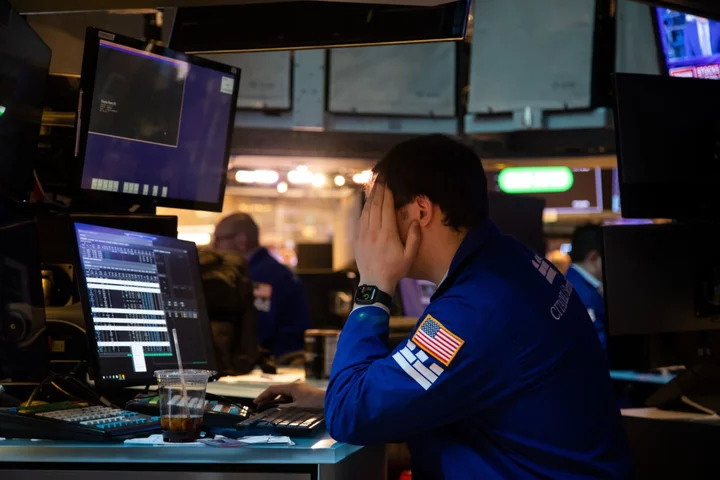Investors are conceding that the Federal Reserve is now intensely focused on fighting inflation and less concerned about higher interest rates breaking the US economy.
That suggests the extraordinary bond market volatility of the past 15 months is set to persist, as 80% respondents to the midyear Markets Live Pulse survey predict the US yield curve will remain inverted into 2024.
Almost half of those who participated in the poll expect at least two more rate increases from the Fed, versus only 19% seeing the hiking cycle as completed. That’s a remarkable shift for a market that as recently as this month had been betting on rate cuts before year end. At the end of last year, a majority of MLIV Pulse respondents expected the main rate to peak at 5.25% or lower.
In a potential warning of a looming downturn, ten-year Treasury yields have been lower than those on two year notes since July. The only two longer periods of inversion were those of August 1978 to May 1980 and September 1980 to October 1981, according to Bloomberg data going back almost half a century. Those episodes were marked by elevated asset-price volatility and back-to-back recessions, prompted by then-Fed Chairman Paul Volcker’s aggressive fight against rampant inflation. If the current inversion lasts until next April it will be the longest ever.
Channeling Volcker after initially betting that surging inflation would prove transitory, Fed Chair Jerome Powell is overseeing the biggest tightening of monetary policy in four decades. While policymakers this month paused the hiking cycle for the first meeting since January 2022, they laid the path for doing more later this year amid inflation that's still more than double their 2% target.
The consequences for markets and the world’s largest economy are manifold. A soft landing now appears elusive and bets have evaporated for the Fed achieving “immaculate disinflation” through a steady tightening of monetary policy. The growing debate among investors is when not if the US economy will start contracting.
Still, investors views on the timing for normalization in the yield curve indicate a recession isn’t anticipated to begin in 2023. That’s because while the yield curve is inverted when it signals a downturn, it’s the inversion starting to disappear that indicates the slump is imminent.
The perspective of the US stuck in the pre-recession limbo for the rest of the year is likely the reason why investors see fixed-income assets outperforming commodities and stocks by year-end.
Bloomberg's Markets Live strategists got the start of 2023 wrong too: they concluded US yields would steepen this year, but have joined readers in abandoning that view:
Read more: Get the Fed Wrong, Get the Curve Wrong Too: MLIV 2023 Update
While the second half might bring volatility, investors see stocks and bonds retaining the inverse correlation of recent months, a dynamic predicted by more than 60% in a survey at the end of last year. That view endorses the conventional 60/40 portfolio-diversification tactics that flopped in 2022.
The median of our readers’ forecasts never stray far from market pricing, which confirms the survey is reaching an appropriately broad selection of investors and validates the informational value from other questions.
The MLIV Pulse survey of Bloomberg News readers on the terminal was conducted by Bloomberg’s Markets Live team, which also runs the MLIV Blog. Click here to sign up for future surveys.
This week, the survey focuses on personal savings and finance conversations over the 4th of July picnic. How much in liquid savings are you targeting this year? Share your views here.

